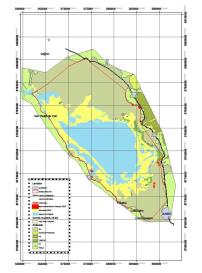
A conservation initiative has helped local communities at Lake Junin Important Bird & Biodiversity Area (IBA) in Peru implement best practices in grassland management. These practices include the construction of cooking stoves with more efficient combustion and, therefore, less use of peat fuel. This initiative has reduced peat extraction and as a result reduced pressure on both migratory and resident bird habitats.

Read this case study in Spanish
Pressures on migratory bird habitats were reduced by decreasing the use of high Andean peat, or champa, through the implementation of best environmental practices, namely, the use of more efficient cooking stoves. The stoves not only reduce the use of peat, but also reduce toxic gas emissions, and provide the same heating properties as more traditional stoves.
The conservation initiative was tackled from two fronts: 1. An environmental education programme to create awareness of the importance of reducing peat use and to generate a more sustainable use of this resource. 2. The implementation of complementary techniques to reduce peat use.
In order to implement the best practices for peat use, both scientific and traditional knowledge from the local communities was used. Information gathered through the project showed a clear increase in champa extraction recently, not only due to increased population growth, but also as a result of the need to improve conditions within peasant homes. Results also showed a clear need for tools to manage resources more efficiently, given that limits imposed on peat extraction per family by local authorities are well below the real requirements of the community, meaning that a large number of families obtain peat illegally.
The more efficient design of the cooking stoves was very successful, reducing toxic gas emission by 75%, often the cause of respiratory problems, and also reducing peat consumption, from 12 to 4 units. Furthermore, the stoves are able to be used with other fuels such as firewood obtained from old wooden crates, vosta (dry cow dung), and inki (soil with dry cow dung), among others. A real commitment exists on the part of the local communities to reduce peat extraction. One community has already reduced its peat use during the 2013 extraction period through the installation of more efficient cooking stoves in only 0.5% of homes. This impact will be increased when all homes using champa are covered by the programme, with evident impacts on the conservation of bird habitat.
Related Case Studies in other sections
Related Sites
Links
Compiled: 2013 Copyright: 2013
Recommended Citation:
BirdLife International (2013)
The use of more efficient cooking stoves is helping bird conservation at Lake Junín IBA, Peru.
Downloaded from https://datazone.birdlife.org/the-use-of-more-efficient-cooking-stoves-is-helping-bird-conservation-at-lake-junín-iba-peru on 22/12/2024